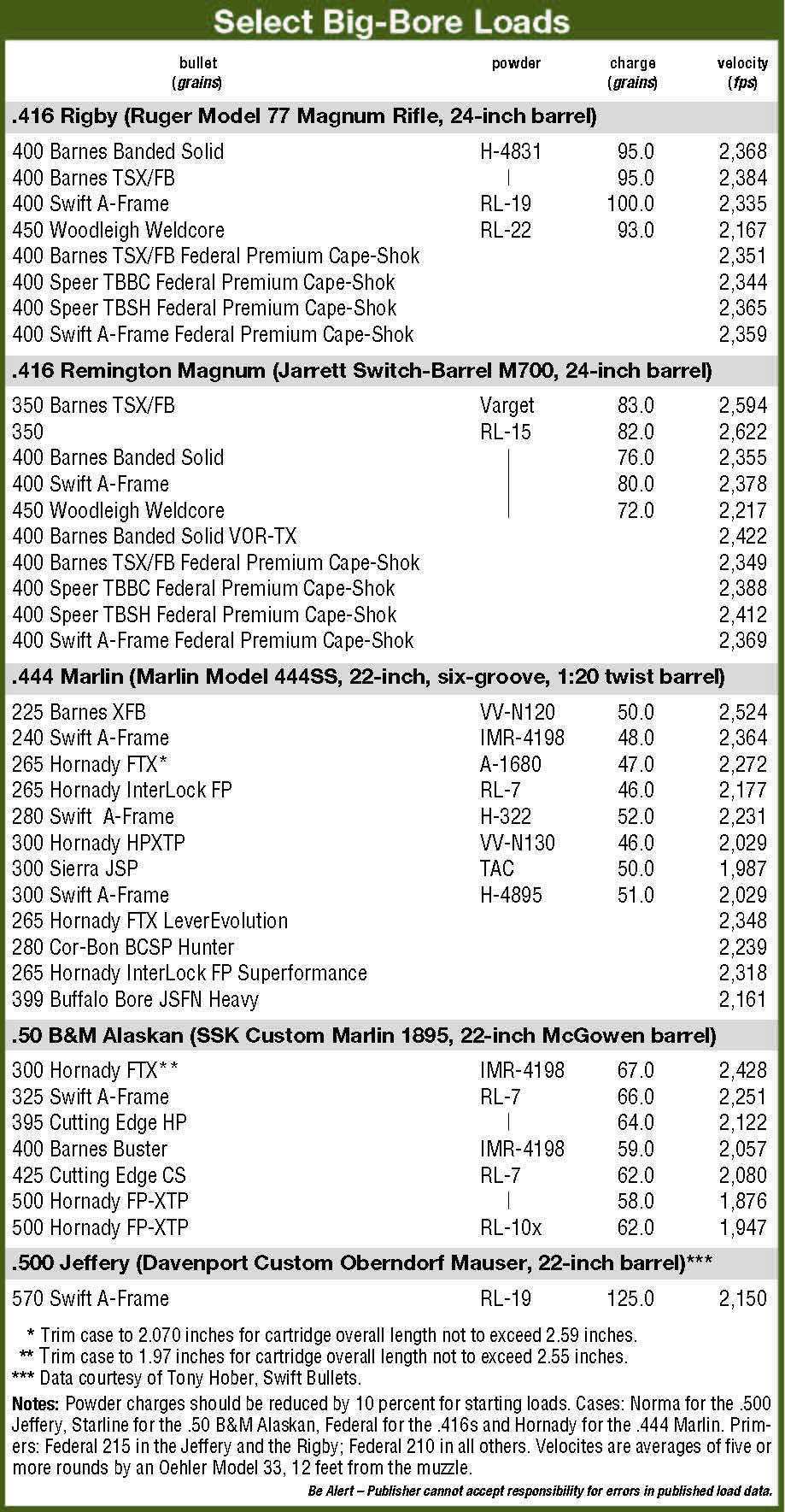The Perfect Big Bore
For enthusiasts, the quest may never end.
other By: Layne Simpson | January, 26
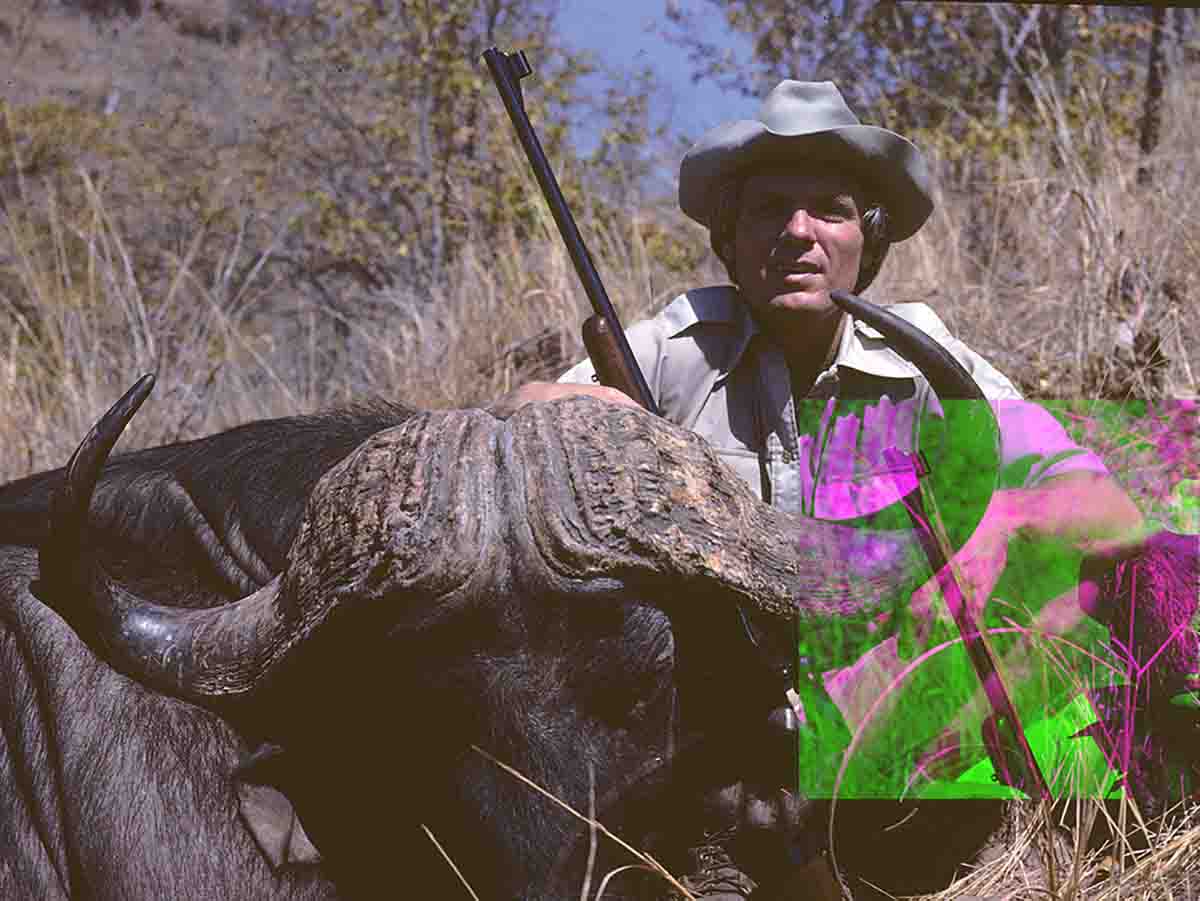




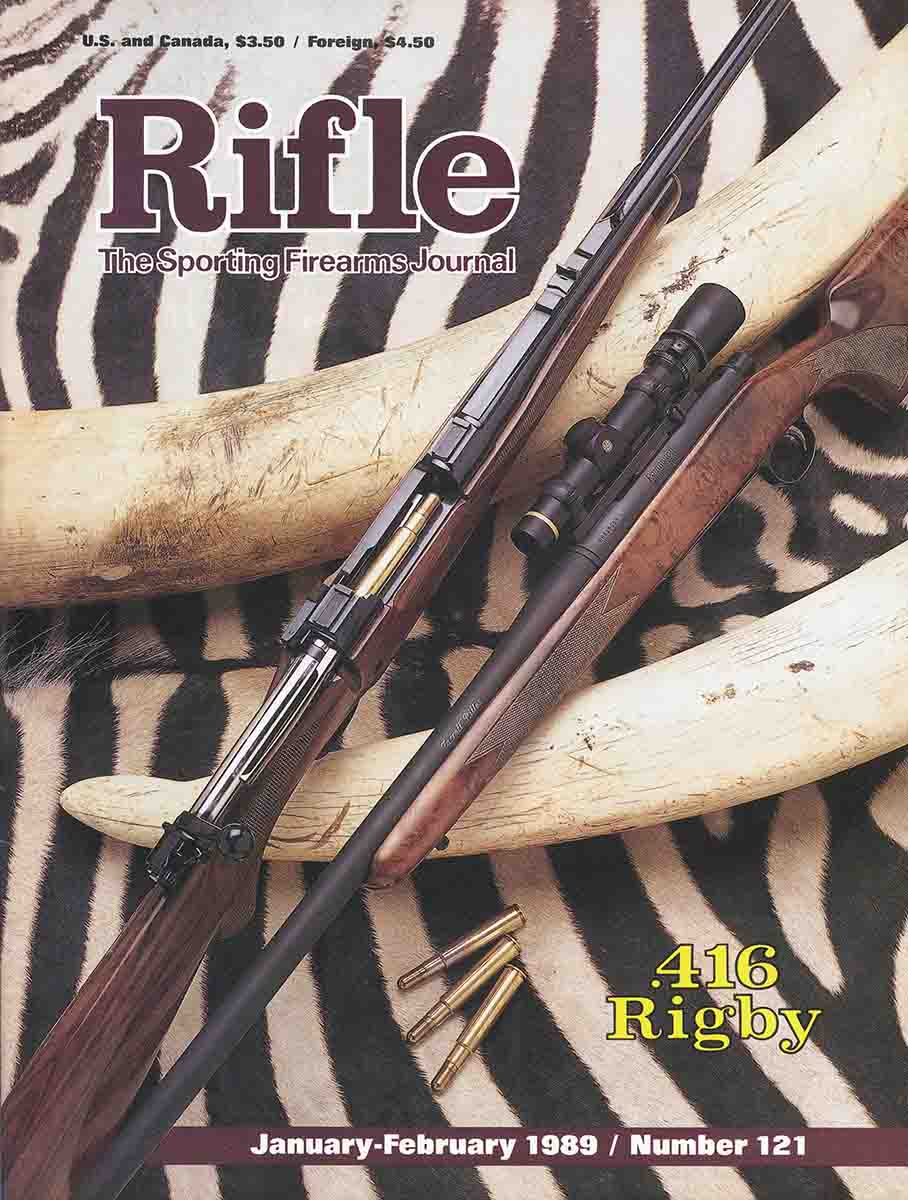
Professional hunter John Tolmay was at the airport when I arrived in Salisbury, and from there we flew to Kariba, then took a long boat ride across Lake Kariba to the Bumi Hills Lodge, located on a tall hill with a magnificent view overlooking the lake. Phil Palmer, another PH, hooked up with us at Bumi Hills. In addition to a Ruger Model 77 .458 Winchester Magnum, John carried a Ruger Mini-14 with a couple of 30-round magazines. Phil had a Mauser in (I believe) .404 Jeffery, as well as his government-issue FN FAL.
My buffalo rifle was a Browning Safari Grade .375 H&H Magnum built on the FN Mauser action. Its two handloads consisted of the Sierra 300-grain softnose and Hornady solid of the same weight over 85.0 grains of H-4831. The plan for the .375 was to use a softnose close behind the shoulder and into the lungs of a buffalo, followed by solids wherever they could be placed. Possibly due to its boat-tail design, the Sierra often shed its jacket, but the lead core was usually found nicely expanded against the offside hide. Some would consider that bullet failure, but the ghosts of several buffalo might argue the point.
The Hornady .375 solid also fell short of perfection in those days. If one of the .458s made by Hornady at the time was recovered, its condition was good enough to allow it to be shot again, should one have chosen to do so. Not so for the .375 solid, as it often bent when encountering heavy bone. Even so, the buffalo shot then and later with the Hornady and Sierra bullets never took more than four shots before tossing in the towel.
My second rifle, a 7mm wildcat on the .308 Winchester case, accounted for a very nice impala. When we later moved to the lowveld, the little 7mm proved to be equally capable of taking greater kudu, sable, reedbuck and various other antelope. For it, there were two handloads, but mostly I used the then-new Speer 160-grain Grand Slam over 50.0 grains of W-785 for a velocity of 2,710 fps. Every animal taken with that rifle was a one-shot kill.
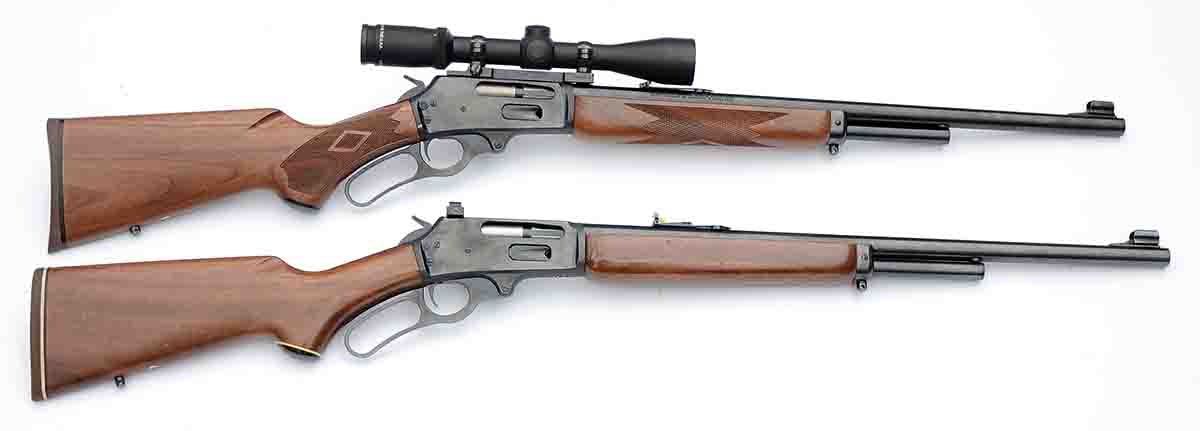

Much better bullets available today for the .375 H&H make it even more effective on large game than when I first used it in the 1970s. I would not hesitate to use it on buffalo tomorrow, but few will argue that moving up in bullet diameter and weight increases cartridge effectiveness on game enough to notice. This brings up the .416s in general and the Rigby and Remington versions in particular.
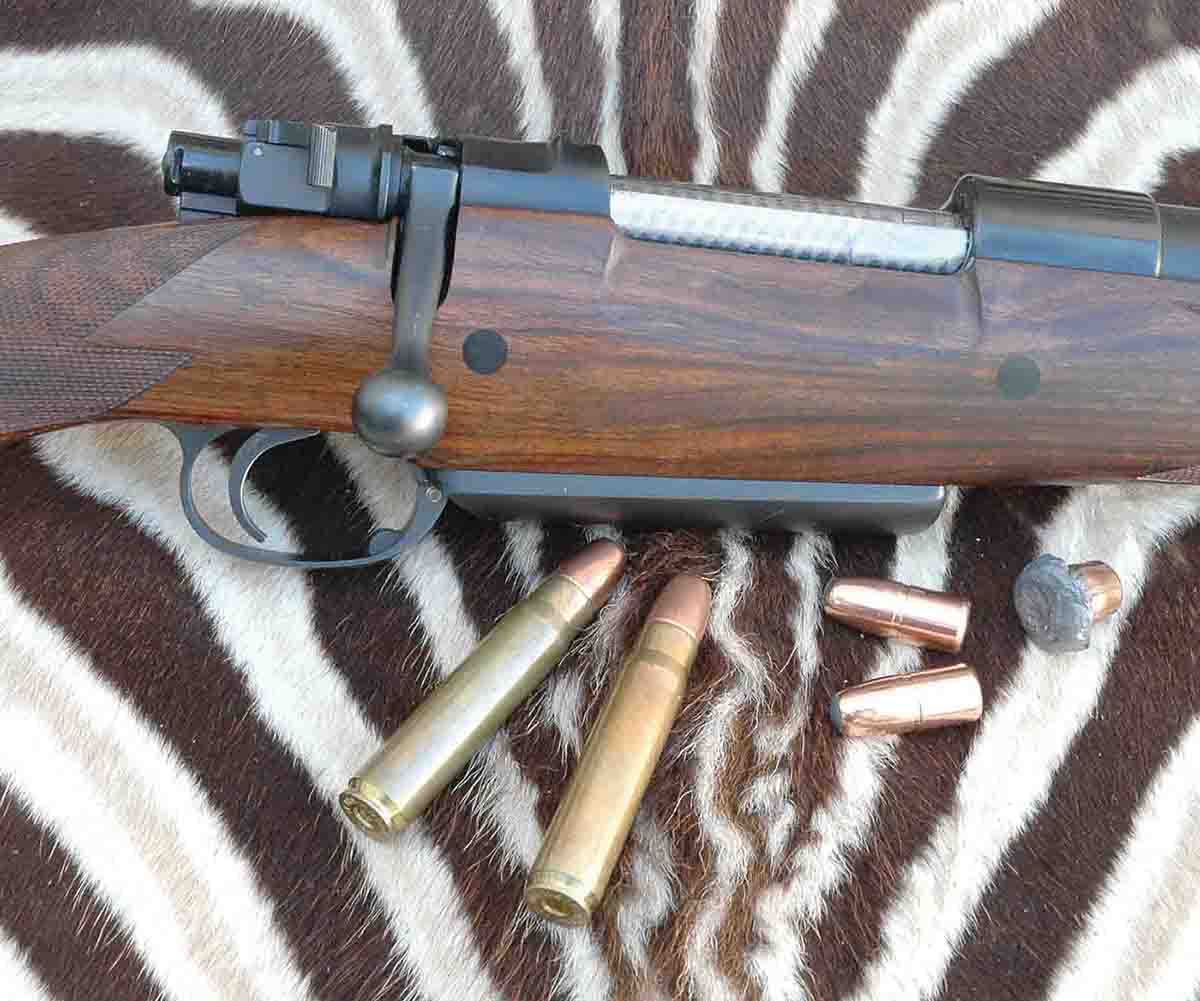
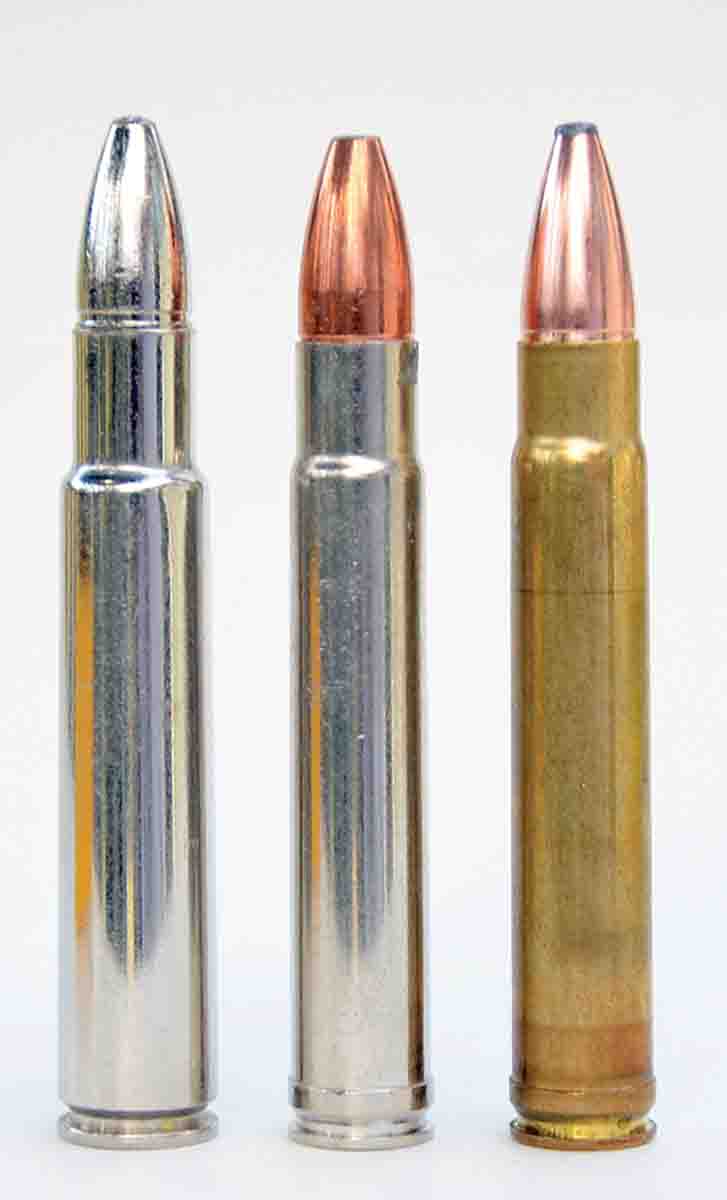
During the 1980s, I came up with several wildcats on the 8mm Remington Magnum case, the first being the 7mm STW built by Kenny Jarrett in 1987. Lesser known is the fact that it was a switch-barrel rifle with its second barrel chambered for the 8mm Remington Magnum case necked up to .416 inch. Clymer ground the chamber reamer and RCBS made the dies. That rifle, its barrel marked “.416 Experimental,” appeared on the cover of Rifle No. 121 (January-February 1989) several months prior to Remington’s official announcement of its .416 cartridge.
Before getting around to writing about the wildcat, I learned that Remington was collaborating with George Hoffman on the development of a commercial version of his .416 cartridge. Hoffman was killing game with his cartridge long before Jarrett built my rifle. The shoulder of the .416 Remington case is a bit farther back than on the .416 Hoffman case, giving it a slightly longer neck, but the ballistics are the same. The Remington cartridge can be fired in a rifle chambered for the Hoffman cartridge – but not conversely.
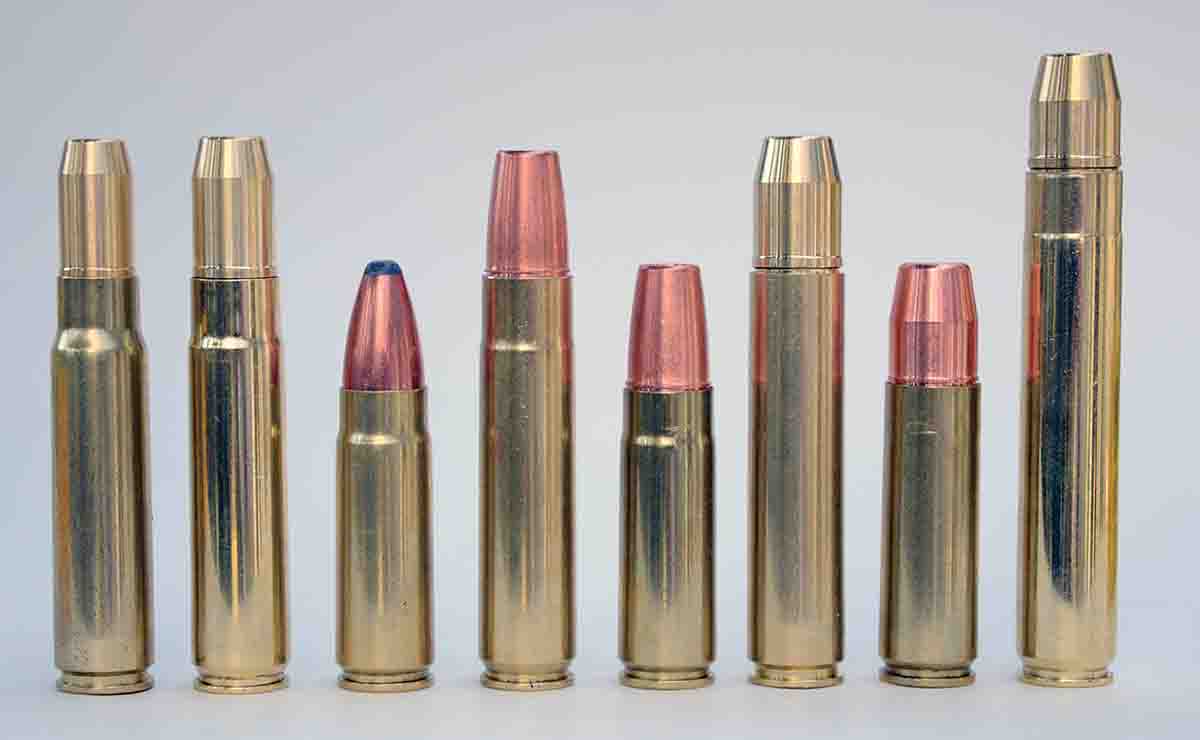
I first used a .416 Rigby only a few weeks prior to the moose hunt in Alaska. Greg Warne, who with his father Jack founded Kimber of Oregon during the 1970s, had just introduced the Model 89 African rifle in various calibers. So we headed to Zambia with a couple of rifles in .416 Rigby and .505 Gibbs, as well as two equally new Kimber Big Game rifles in .270 Winchester. At the time, elephant had recently been heavily culled in the area, and it seemed every cow we encountered had a big chip on her trunk. Only a few weeks prior, our PH Johan Potgieter was driving through tall grass when a cow suddenly appeared, plucked one of the guys from the back of the safari car and ended his life in a flash. I did manage to put the .270 and .416 through their paces, and one of the .416 Rigby rifles we hunted with also appeared on the cover of the Rifle issue mentioned earlier.
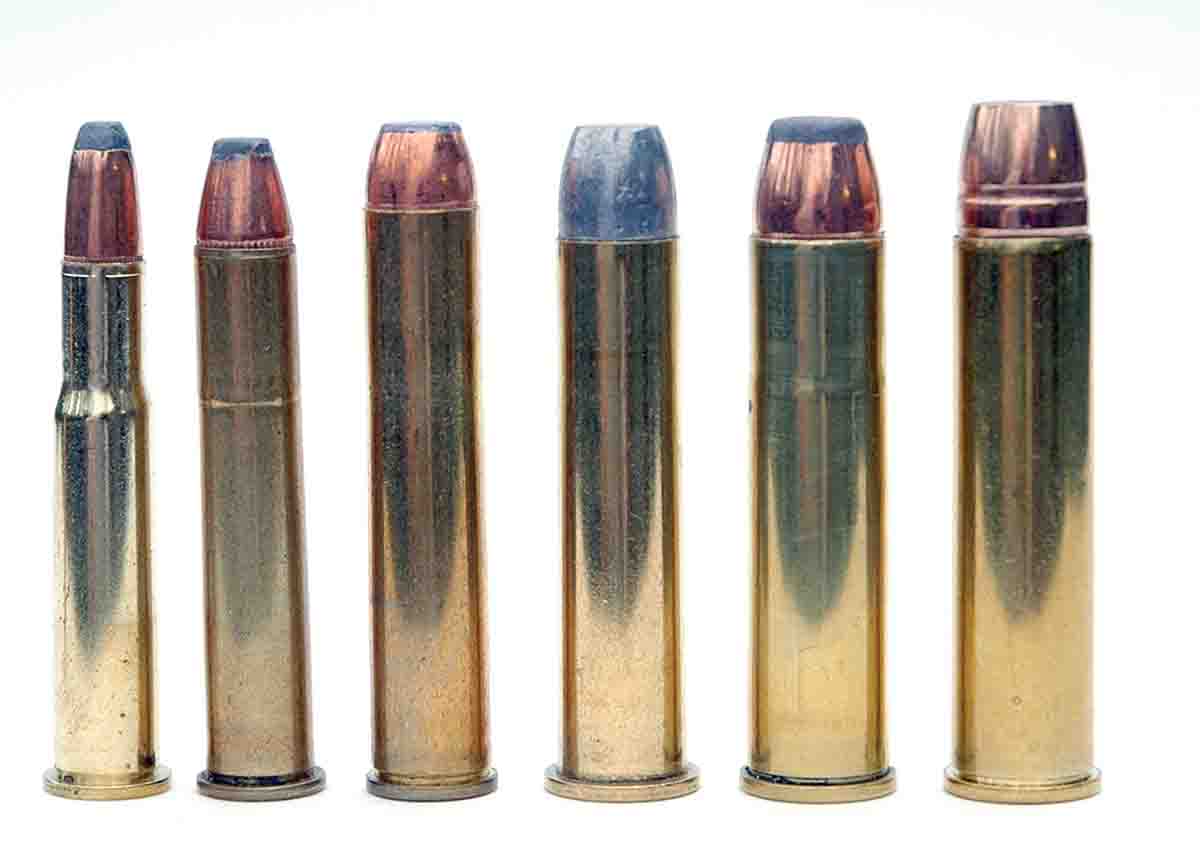
For the Rigby, 400-grain Swift A-Frame and A-Square monolithic solids were handloaded, both at 2,375 fps. While in Zambia, I grew quite fond of the cartridge, and when it became available in the Ruger Model 77 Magnum in 1989, I immediately purchased one. A second one in .375 H&H soon joined it. Both wear identical Zeiss DiaVari C 1.5-4.5x scopes.
If I were a brown bear guide in Alaska, the .416 Remington would be the first choice simply because of its availability in rifles of less weight. Due to the larger powder capacity of the Rigby case, it reaches the same velocities with 400- and 450-grain bullets at considerably lower chamber pressures, and for that reason it is a better choice for the heat of Africa.
I have a soft spot for lever-action rifles, so my quest for the perfect big bore has not been restricted to bolt guns. Four have bores bigger than the .38-55 Winchester I used to take a nice black bear on Vancouver Island. All are Marlins, two custom and two off-the-shelf. One, stocked in very nice American walnut by Bob Cassidy, is one of the first New Model 1895s in .45-70 to leave the factory in 1972. First-year rifles are easily recognized by a straight-grip stock, square-shaped finger lever and front sight dovetailed to the barrel. A closer look will reveal 8-groove rifling, which eventually was changed to 12 groove.
Not too long ago, the .45-70 fired a five-shot group at 100 yards measuring .354 inch, the smallest I have shot and probably will ever shoot with any lever action. It is by no means typical of what the rifle is capable of doing on a consistent basis, but it is proof that a good load fired in a good Marlin by a rifleman who occasionally gets lucky can result in a bragging-size group. The load consists of a Federal case, a Federal 210 primer and a Hornady 325-grain FTX bullet over 51.0 grains of Reloder 7.
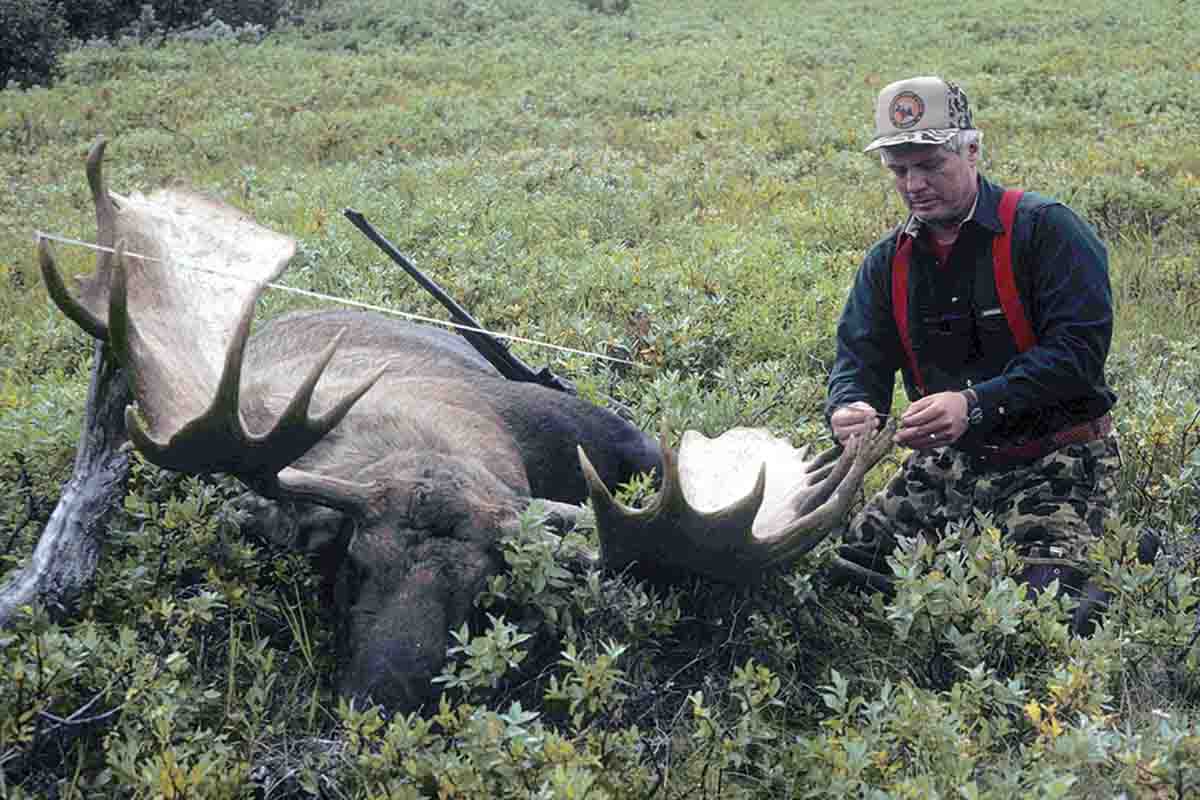
A lever-action rifle in .444 Marlin is hardly the ideal choice for open-country hunting, but a hunter who does his homework can get by with it. I first learned of its existence while in college. The cartridge was brand new at the time, and prior to its introduction, several Marlin employees had used it on caribou in Canada. Little did I realize at the time that about four decades later, 2003 to be exact, I would receive an invitation from Marlin to hunt caribou in Canada. I also had my pick of rifles. This was before the .308 and .338 Marlin Express cartridges were introduced, but even if they had been available at the time, I probably would have chosen the .444 Marlin simply because of the article I had read so many years before.
The load settled on, 54.0 grains of H-322, pushes a Swift 280-grain A-Frame along at 2,231 fps. Zeroed 3.5 inches high at 100 yards, it is dead-on at 200 yards. Using the first and second tick marks on the lower quadrant of the vertical crosshair of a Burris 3-9x Fullfield scope for aiming puts the A-Frame dead-on at 250 and 300 yards. Accuracy for five shots seldom exceeds 1.5, 2.75 and 4.5 inches at 100, 200 and 300 yards. That knowledge, along with a laser rangefinder, allowed me to easily take a nice caribou bull at 248 yards.
All the world’s game animals requiring nothing less than a big-bore rifle are easily counted on one hand, and only a very small percentage of hunters are fortunate enough to hunt one or more of them. Yet many big-bore rifles continue to be sold each year. I am told that the majority of big guns purchased by Americans are never taken out of the country. Whether or not this is true I cannot say, but a survey by Winchester some years after the .458 Winchester Magnum was added to the Model 70 revealed that a surprisingly small number sold were actually hunted with. Yet our fondness for thumb-sized bullets and big holes through rifle barrels seems to never fade.
Several friends own rifles chambered for big cartridges for different reasons. One is an avid bullet- caster who has probably pushed about a half-ton of scrap wheelweights through his Ruger No. 1 .458 Winchester Magnum. Another has a library full of books on Africa, and while he enjoys reading about hunting there, he has no interest in doing so himself but owns vintage rifles chambered for several big cartridges, including O’Connor’s old favorite buffalo-thumper, the .450 Watts. Others have no special interest in big bores but simply prefer to take an old classic on their one and only safari. Another friend borrowed money to purchase a very handsome Westley Richards double .470 Nitro Express. He went to Africa, got his elephant and buffalo and soon after returning home sold the .470 for more than he paid for it.
Long after the last elephant is shot and buffalo are too expensive for most of us to shoot, big-bore rifles and cartridges will remain popular, not because they are actually needed but due to the love and affection so many of us have for them. Swift Bullets’ Bill Hober and son Tony are examples. Among other game, Bill has taken several elephant with his Holland & Holland double .470 Nitro Express.
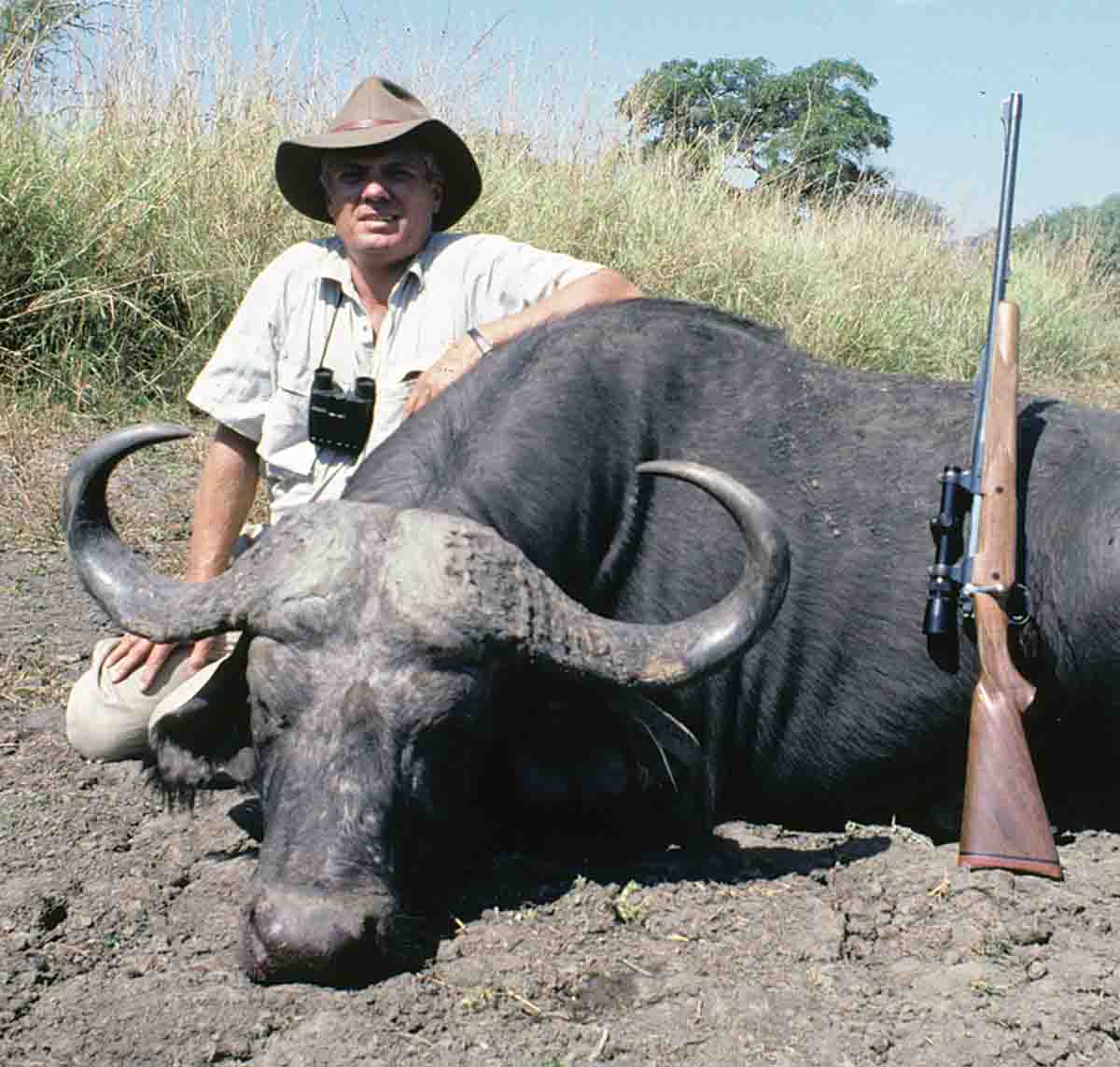
A couple of years ago Tony began planning a hunt for Cape buffalo in Zimbabwe with Clinton Rogers. When Christmas rolled around, Santa surprised him with a custom rifle built on a Oberndorf Mauser action by Sterling Davenport. I have handled the rifle and found it to be magnificent to say the least. One of the .416s or perhaps a .458 would have been a practical choice in cartridges, but Tony got his buffalo with a single 570-grain bullet from the .500 Jeffery at 40 yards. A PH’s dream come true, he practiced shooting the rifle offhand (no shooting sticks) until he was quickly and consistently keeping a magazine full of shots inside 2.0 inches at 50 yards.
Michael McCourry is another friend whose hobby (or perhaps addiction) is developing big-bore cartridges. Rather than simply creating a new cartridge and leaving it at that, he comes up with a complete package consisting of the perfect bullet and rifle for the cartridge. I have lost count of the number of times he has been to Africa and Australia. His creations range in size from 9.3mm to .500, some almost as long as your arm, others on super-short cases for the Winchester Model 70 WSSM action.
My latest custom rifle is a Marlin New Model 1895 chambered for Michael’s .50 B&M Alaskan. It pushes 450- and 500-grain bullets along at 2,000 and 1,950 fps. Built by SSK Industries, the 22-inch McGowen barrel has Masterpiece open sights made by N.E.C.G., No. 61 Adjustable at the rear and No. 661 Banded Ramp with the S-4 sight up front. In addition to a fixed, 3⁄32-inch silver bead, the front sight has a 11⁄64-inch white bead.
The larger front bead can be hinged up in front of the smaller bead for use when light is bad or hinged down out of the way when it is not needed. The idea goes back well over a century and was an option offered on sporting rifles by English makers. The British called it a “night sight,” and the white folding bead was often made from warthog tusk, because it does not turn yellow with age as elephant ivory is prone to do. The .50 also wears a Weaver V3 scope attached to the SSK T’SOB base with Warne quick-detach rings.
Unlike Harold Johnson’s original .50 Alaskan and its .510-inch bullet, the B&M uses .500-inch bullets made for the .500 Smith & Wesson revolver cartridge. The 500-grain Hornady FP/XTP, as well as several bullets from North Fork and Cutting Edge in that diameter, have proven capable of handling any game the cartridge is suitable for, but I also wanted the option of using the Swift 450-grain A-Frame and the 500-grain Woodleigh. These are .510-inch diameter, but one trip through a Corbin .500-inch draw die in a CSP-1 press takes care of that. Only someone who does not appreciate big-bore rifles and cartridges would dare ask why someone would go to so much trouble to shoot something they honestly do not need.


